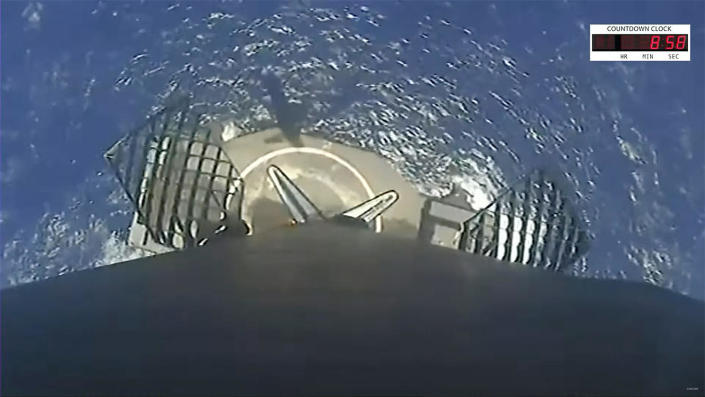SpaceX launches space station resupply mission
A SpaceX Dragon cargo ship loaded with 7,000 pounds of supplies and equipment, including two add-on roll-out solar blankets, thundered away from the Kennedy Space Center atop a Falcon 9 rocket Monday, kicking off an 18-hour trip to the International Space Station.
After missing launch opportunities Saturday and Sunday because of weather and unspecified work, the Falcon 9 finally roared to life at 11:47 a.m. EDT and quickly climbed away from historic pad 39, arcing onto a northeasterly trajectory matching the station's orbital track.

The first stage, making its fifth flight, boosted the rocket out of the lower atmosphere before separating and flying itself to touchdown on an off-shore landing barge. The second stage continued the climb to orbit, releasing the unpiloted Dragon to fly on its own about 12 minutes after liftoff.
If all goes well, the ship will carry out a series of automated rendezvous rocket firings to catch up with its quarry Tuesday morning, moving in for docking at the Harmony module's space-facing port at 5:50 a.m.
Packed in its pressurized cabin, the section of the Dragon accessible to the crew inside the station, are 2,420 pounds of crew supplies, 1,082 pounds of space station hardware, 586 pounds of science gear and 115 pounds of spacewalk and computer equipment.

Housed in the Dragon's unpressurized lower trunk section are two ISS roll-out solar array blankets, or IROSAs, the fifth and sixth to be added to the station to augment the lab's aging solar panels.
The two new IROSAs will be pulled out of the Dragon's open trunk by the station's robot arm and mounted near the right end of the station's solar power truss. Astronauts Steve Bowen and Woody Hoburg plan to install them during spacewalks on June 9 and 15.
The space station is equipped with four primary solar array wings, two on each side of the power truss. Each wing is made up of two 39-foot-wide blankets extending 112 feet in opposite directions. The first two-blanket wing was launched in December 2000 with additional pairs delivered in 2006, 2007 and 2009.

Solar cells degrade over time and NASA is adding six IROSAs, at a cost of $103 million, to the existing power system. Each 20-foot-wide roll-out blanket is attached to the base of an already existing array, extending 63 feet when fully deployed and each generating more than 20 kilowatts of power.
Even though the IROSAs block portions of the underlying arrays from the sun, the station's upgraded system will provide about 215,000 watts of power overall, roughly equivalent to the output the original arrays generated when they were new.
NASA plans to order a final two IROSAs in the near future to provide the power needed to support agency-sponsored research, anticipated commercial activity and the addition of one-or-more commercial modules between now and the station's retirement at the end of the decade.
"Great Resignation" is over -- here's what that means for U.S. economy
Prince Harry's a no-show on first day of phone hacking trial

